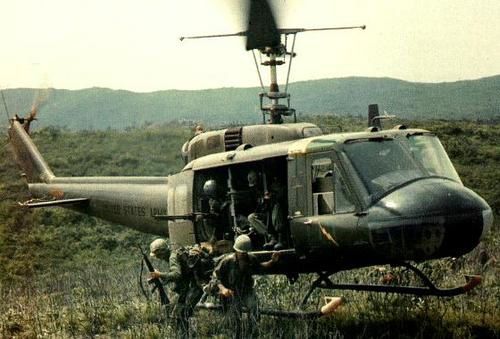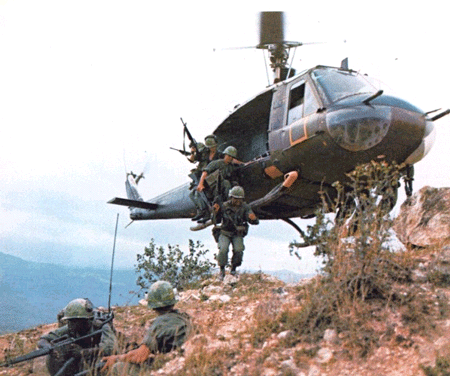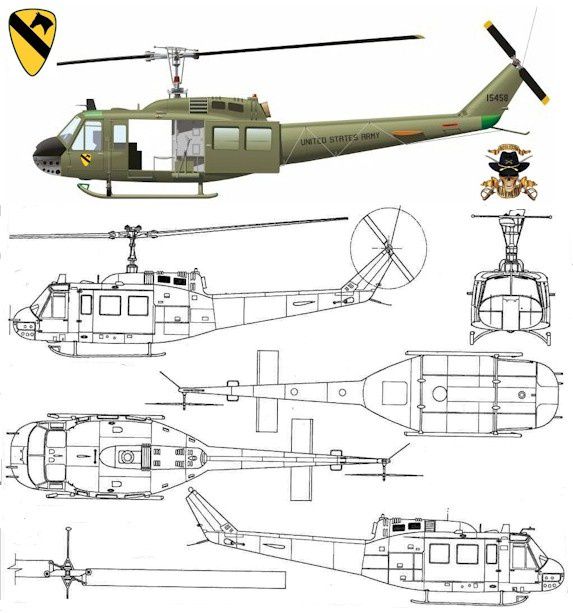


![]()
![]()

UH-1 Iroquois (Huey)
The Huey story traces back over four decades. A great advance in helicopter propulsion had come in the 1950s with the adaptation of the gas turbine engine to helicopter flight. The piston-drive engines used in Korea and on the Army's UH-34 utility helicopters in the 1950s and early 1960s had produced only one horsepower for each three pounds of engine weight. New gas turbine engines had a much more favorable efficiency ratio. This permitted the construction of small, low-profile aircraft. One of the most important milestones during this period was the decision to develop the XH-40 Bell Utility Helicopter and to power it with a turbine engine. Although designed as an aerial ambulance, it was recognized even then that this machine might turn out to be the most useful aerial platform ever put in production.
In 1955, with an interest in a utility helicopter designed around a turboshaft engine, the Army had the Air Force develop a new helicopter for its use. At that time the Army did not have its own aircraft development capability. The design competition was for the first helicopter for the Medical Service Corps, whose primary mission was to be used for aeromedical evacuation. The winner of this competition was Bell Helicopter Company with its model, the XH-40. The design selected, Bell's Model 204, was to be powered by a new Lycoming T-53 engine of some 850 shaft horsepower and featured a typical Bell two-blade teetering rotor.
This was the first turbine-powered helicopter for the Army. First flight of the new design was in October 1956, development and production following in 1959. The early Bell XH-40 had been standardized as the HU-1 and was envisioned then as the replacement for the L-20 utility airplane and the H-19 utility helicopter. Further growth versions of the Bell machine were planned to replace the bulk of the missions then performed by the Sikorsky H-84 and the Vertol H-21.
In the original helicopter designation series, the first three aircraft received the XH-40 designation. When the Army adopted its own two-letter designation system, the H-40 became the HU-1 (Helicopter Utility). From this designation came Huey, the name by which it has remained known. The DOD standard designation system reversed this to UH-1, the first designation in the new DOD helicopter series. With larger engines and increased capacity, the UH-1 was developed through successive models. Within the series, the Model 204 had suffixes A, B, C, E, F, K, L, M and P. The Model 205 carried either the D or H suffix. The Model 212 was the UH-1N, the primary 1st Special Operations Wing Huey, while the Model 412 was the 212 with a four-blade rather than two-blade motor.
The single engine Models 204 and 205 were skid-equipped helicopters with a single, two-blade, all-metal, anti-torque tail rotor mounted on the left side of the tailboom. The all-metal, semi-monocoque fuselage could accommodate two crewmen and seven passengers in the Model 204 and two crewmen and 11 passengers in the Model 205. They also differed in fuselage and rotor dimensions, engines and performance. They served in gunship, casualty evacuation, search and rescue, vertical envelopment-attack transport, antisubmarine warfare and general utility roles during their long service life.
The HU-1A was the first of three major variations of the Iroquois belonging to the Model 204 series, which has a 44-foot diameter rotor. Deliveries of the HU-1A with a T53-L-1A engine began June 30, 1959, for utility transport and casualty evacuation with six seats or two stretchers. The first element of fifteen armed Hueys was deployed to Vietnam in September 1962. Initially, the fifteen UH-1A helicopters were armed with locally fabricated weapons systems consisting of two .30 caliber machine guns and sixteen 2.75-inch rockets. In November 1962 the unit was augmented with eleven UH-1B helicopters.
The HU-1B followed, which with a 960-horsepower T53-L-5 engine accommodated eight passengers on three stretchers. It became the UH-1B when the HU designation changed to UH. The early experience with unarmed Hueys, often called "Slicks," being shot down led to the development of the UH-1B, the Army's first gunship.
This model served in Vietnam in various roles including armed support. The UH-1B model did not begin its user evaluation testing until 28 November 1960. By June of 1963, most of the light helicopter companies had phased in the new UH-1B helicopters and had transitioned their aviators, maintenance personnel, and crew chiefs to the new aircraft. But, it would not be until 27 June 1964 that the last tired old CH-21 was formally retired by General Oden, Acting Commanding General, U, S. Army Support Command, Vietnam. The "B's" were equipped with factory installed weapons systems of four M-60 machine guns per aircraft and locally fabricated clusters of eight 2.75-inch rockets.
The "B" model eventually replaced most of the less powerful "A's." The armament system brought the armed UH-1B up to its maximum gross weight thereby eliminating it from a troop or cargo-carrying role. In addition to the integrated machine gun and rocket systems, two door gunners were used on the armed helicopters. Southeast Asia was the proving ground for the gunship and demonstrated its value and potential. Although the A- and B-model Huey engine often lacked enough power to work in the heat and high altitudes of South Vietnam, it was much stronger than earlier Army helicopter engines. But the high density altitudes encountered in II Corps Zone in Vietnam meant that the UH-1A and UH-1B with a full crew-pilot, aircraft commander, crew chief, and medical corpsman-often could carry no more than one or two patients at a time. 
The UH-1C was the last in the Model 204 series, with a 1,000-horsepower T-53-L-11 engine.
The UH-1D was the first of a larger Iroquois, designated Model 205, which flew not long after deliveries of the original HU-1s began. It had a longer fuselage than previous models, a larger 48-foot diameter rotor, increased range, and a more powerful Lycoming T53-L-11 1100 shp engine, with growth potential to the Lycoming T53-L-13 1400 shp engine. A distinguishing characteristic is the larger cargo doors, with twin cabin windows, on each side. The UH-1D was redesigned to carry up to 12 troops, with a crew of two. The UH-1D has a range of 293 miles (467km) and a speed of 127 mph (110 knots).
The longer rotor blade on the UH-1D gave it more lifting power, but high density altitudes in the northern two corps zones, where U.S. troops did most of their fighting, still prevented Dust Off pilots from making full use of the aircraft's carrying capacity. UH-1D "Hueys" could be armed with M60D door guns, quad M60Cs on the M6 aircraft armament subsystem, 20mm cannon, 2.75 inch rocket launchers, 40mm grenade launcher in M5 helicopter chin-turret, and up to six NATO Standard AGM-22B (formerly SS-11B) wire-guided anti-tank missiles on the M11 or M22 guided missile launcher. The UH-1D could also be armed with M60D 7.62mm or M213 .50 Cal. pintle-mounted door guns on the M59 armament subsystem. The US Army bought many of these, and deliveries began in 1967. Ultimately more than 600 were transferred to South Vietnam and 32 to Cambodia. UH-1Ds were build under license in Germany. Bell also sold them with the UH-1N, with its more powerful engine, the T-53-L-13 with 1,400 horsepower.
The UH-1E was a versions of the main variant for the Marines as an assault support helicopter, which Bell developed from the UH-1B. In 1962, after an evaluation of available types, the UH-1E version, generally similar to the Army's UH-1B, was ordered for the Marine Corps. These went into service in 1964 with VMO-1 being the first squadron to receive them. Subsequently, 209 UH-1E aircraft were delivered to the Marines by 1968.
All, after the first 67, were equipped with an improved rotor system. Like their Army counterparts, the Marine Hueys served all manner of combat roles, including that of armed gunships. For combat operations in Southeast Asia, a Navy Light Attack Helicopter squadron was also established using UH-1Bs acquired from the Army.
The UH-1F, a 1,100-horsepower General Electric T58-GE-3 engine for use in a support role, was ordered in 1963 by the Air Force.
The HH-1H was an Air Force rescue version, of which thirty were ordered.
The HH-1K was a Navy model based on the UH-1E equipped for air station search and rescue duty.
The TH-1L was a Navy advanced instrument trainer version.
The UH-1L was a Navy standard utility configuration .
The UH-1M Army helicopters were equipped for night weapons firing
The UH-1P was ordered by the Air Force for psychological warfare in Vietnam. The first Huey helicopter assigned to Hurlburt Field was the UH-1P, which was among the 16 types of aircraft assigned there in 1969. Although the Huey helicopters were reliable aircraft, military flying has always been and will always be a hazardous operation. A UH-1P flying near Eglin Air Force Base struck a power line and crashed, killing all five crewmembers, Sept. 2, 1969. Three weeks later, Sept. 24, Detachment #1 activated under the 1st SOW as a separate UH-1P helicopter unit. It became the 317th Special Operations Squadron April 15, 1970. The following September 16, the first UH-1N student class arrived at Hurlburt Field and UH-1P training ended. 
The most widely used military helicopter, the Bell UH-1 series Iroquois, better known as the "Huey", began arriving in Vietnam in 1963. The Huey showed how versatile it was during the Vietnam War, performing a great variety of rear-echelon chores and rapidly moving troops to front line positions. Before the end of the conflict, more than 5,000 of these versatile aircraft were introduced into Southeast Asia. "Hueys" were used for MedEvac, command and control, and air assault; to transport personnel and materiel; and as gun ships.
In Vietnam, the "Huey" was used extensively for Medevac and demonstrated, very convincingly, the life saving potential of rapid trauma evacuation. The mortality rate in Vietnam was less than 1 per 100 casualties as compared to 4.5 deaths per 100 casualties in World War II and 2.5 per 100 in Korea. While there were advancements in medical procedures, the preponderance of the success must be credited to the speed and volume with which the injured reached definitive medical care.



![]()


| UH-1 Iroquois Specifications | UH-1A | UH-1B | UH-1C | UH-1D | UH-1E* | UH-1H |
| Engine (shaft-turbine) | T53-L-1A | T53-L-5 | T53-L-11 | T53-L-11 | T53-L-11 | T53-L-13 |
| Shaft horse-power | 860shp | 960 shp | 1,000shp | 1,100shp | 1,100shp | 1,400shp |
| Rotor diameter (Imp) | 43ft 9in | 44ft | 44ft | 48ft 3in | 48ft 3in | 48ft 3in |
| Rotor diameter (metric) | 13.31m | 13.39m | 13.39m | 14.68 | 14.68 | 14.68 |
| Overall length (Imp) | 52ft 10in | 53ft 11in | 53ft | 57ft 1in | 57ft 1in | 57ft 1in |
| Overall length (metric) | 16.07m | 16.41m | 16.13m | 17.37 | 17.37 | 17.37 |
| Skid track (Imp) | 7ft 10in | 7ft 10in | 7ft 10in | 7ft 10in | 7ft 10in | 7ft 10in |
| Skid track (metric) | 2.37m | 2.37m | 2.37m | 2.37 | 2.37 | 2.37 |
| Overall height (Imp) | 14ft 7in | 14ft 7in | 14ft 7in | 14ft 7in | 14ft 7in | 14ft 7in |
| Overall height (metric) | 4.43m | 4.43m | 4.43m | 4.43m | 4.43m | 4.43m |
| Weight empty (Imp) | 4,020lbs | 4,502lbs | 4,830lbs | 4,900lbs | 4,900lbs | 4,900lbs |
| Weight empty (metric) | 1,823kg | 2,042kg | 2,190kg | 2,222kg | 2,222kg | 2,222kg |
| Weight loaded (Imp) | 9,195lbs | 11,206lbs | 13,300lbs | 8,500lbs | 8,500lbs | 8,500lbs |
| Weight loaded (metric) | 4,165kg | 5,083kg | 6,046kg | 3,855kg | 3,855kg | 3,855kg |
| Max speed loaded (sea level) (Imp) | 120mph | 138mph | 148mph | 148mph | 148mph | 148mph |
| Max speed loaded (sea level) (metric) | 193km/h | 222km/h | 238km/h | 238km/h | 238km/h | 238km/h |
| Cruising speed (Imp) | 106mph | 126mph | 136mph | 130mph | 130mph | 130mph |
| Cruising speed (metric) | 170km/h | 202km/h | 219km/h | 209km/h | 209km/h | 209km/h |
| Range loaded (with reserves) (Imp) | 230miles | 253miles | 270miles | 260miles | 260miles | 260miles |
| Range loaded (with reserves) (metric) | 370km | 407km | 434km | 418km | 418km | 418km |
.![]()

.


After several years, the Army jettisoned the pentomic division as too weak and too unwieldy on the battlefield. In 1963, the battle group was redesignated as the 1st Battalion, 7th Cavalry, at the time a straight-leg infantry battalion. At about the same time, the 11th Air Assault (Test) Division was conducting the first applications of airmobility using helicopters at Fort Benning, Georgia, and in 1965, it assumed the colors of the 1st Cavalry Division (Airmobile).
In August 1965 the 1st and 2nd Battalions, 7th Cavalry sailed for South Vietnam. By this time, they had completed their initial training and were full-fledged air assault infantry battalions. Upon reaching Vietnam in September 1965, the 1st Cavalry Division began the construction of a massive firebase in the Central Highlands region of the Republic of Vietnam. In November 1965, the National Liberation Front (Viet Cong) attacked the Special Forces camp at Plei Mei. The division moved into the area, with the intent of trapping the Viet Cong forces between Plei Mei and the Laotian border.
1-7 landed in Landing Zone X-Ray, a small open field in the Ia Drang valley, to search for and destroy units on 14 November 1965. They landed in an area with nearly three full-strength regiments of the North Vietnamese Army and into what would become the first major battle of the Vietnam War.
1-7's battalion commander, LTC Harold G. Moore ,had planned for a possible piecemeal engagement before all of his elements closed on LZ X-Ray, but they were nearly overwhelmed by the superior numbers of the NVA. Eventually 1-7, with elements of 2-7 were able to bring massive air, artillery, and aerial rocket artillery (helicopter) fires into the area. Once the codeword "Broken Arrow" was given, it meant that a US unit was in danger of being overrun and, upon acknowledgment, meant that the calling unit had priority of all aircraft in country. 1-7 and 2-7 had aircraft stacked at thousand foot intervals from 5000 to 30,000 feet waiting to drop ordnance.
Tactical air support was not the only air asset in the Ia Drang that day. For the first time, B-52 Stratofortress strategic bombers flew in direct support of a ground unit. One of the lasting concepts from the Ia Drang battle was that of the "Mad Minute," where for one minute every weapons system in the battalion would fire into the bush. These uses of overwhelming firepower and the intelligent deployment of ground units (to include units that arrived during the battle) allowed LTC Moore to save his command and destroy the 66th NVA Regiment (and also maul the 33rd and 320th NVA Regiments). This, the first battle between US and NVA ground forces, was a tremendous tactical victory, and validated the concept of airmobile infantry under the most rigorous battlefield conditions.
1-7, 2-7, and later, the newly-created 5-7 served in the 1st Cavalry Division through the war until 1972, and near the end, with all three battalions of the 7th Cavalry in 3rd Brigade, 1st Cavalry Division, the brigade picked up the nickname "Garryowen Brigade."
![]()


![]()

 Colonel, now Lt. Gen.(Ret.) Hal Moore and CSM Basil Plumley
Colonel, now Lt. Gen.(Ret.) Hal Moore and CSM Basil Plumley
.
.
.
![]()





















/idata%2F0396584%2FKOREA%2F71910_korea_MIA1_800.JPG)
/idata%2F0396584%2FU.S.ARMY-POST-WW2%2Fphot4901a.jpg)
/idata%2F0396584%2FDRAWINGS-UNIFORMS-WW2%2F30-451-09b-2.jpg)
/idata%2F0396584%2FP-40%2F44FS000.jpg)
/idata%2F0396584%2FGERMAN-U-BOAT%2FBundesarchiv_Bild_101II-MW-1031-28-_Lorient-_U-31.jpg)
/idata%2F0396584%2FSOVIET-ARMY-WW2%2F1.jpg)





